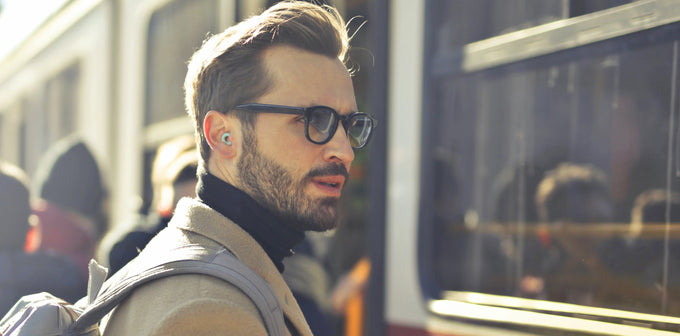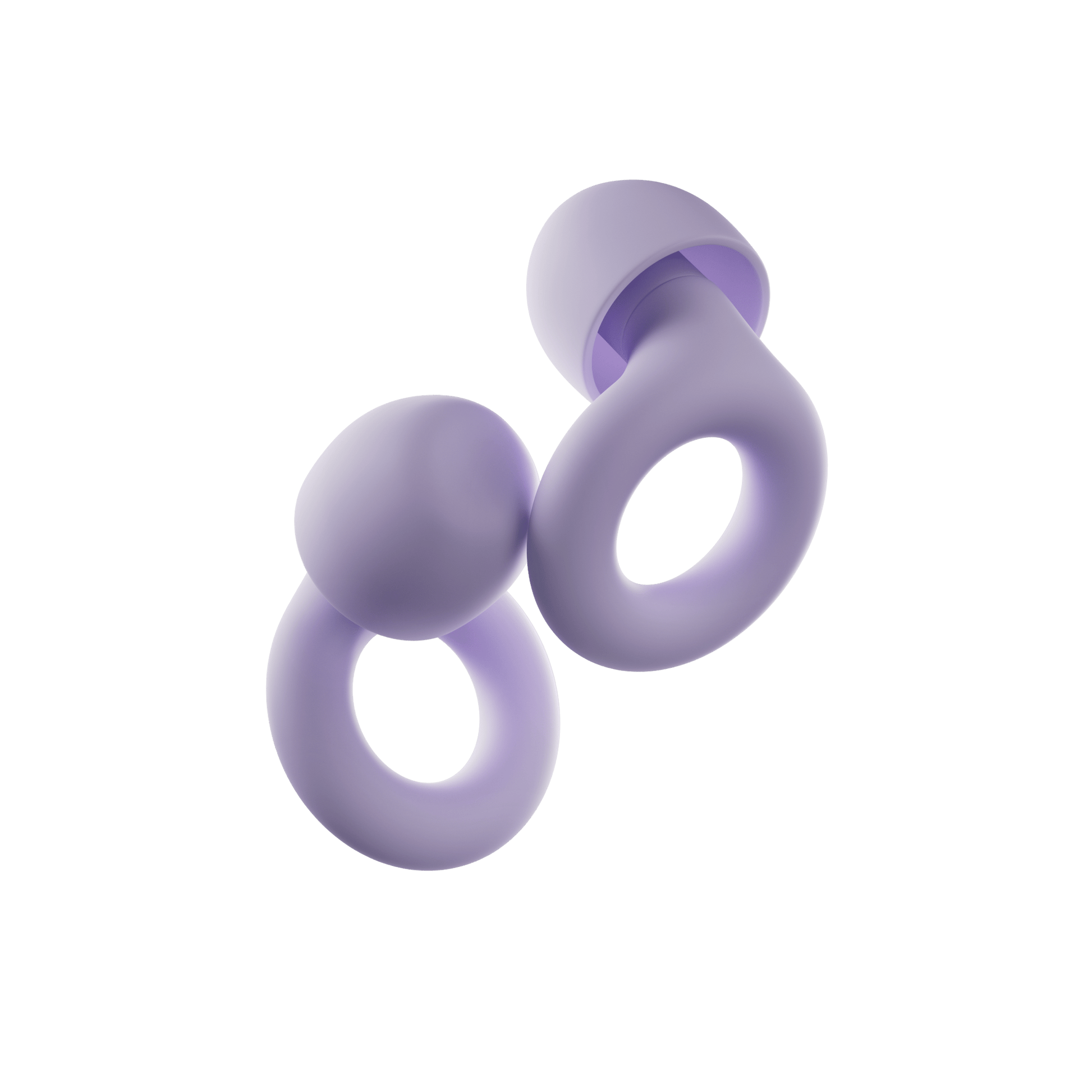Key takeaways
- Planes are not known for their comfort. Between noise from other passengers, travel announcements and lack of personal space, it’s a challenge to relax.
- To increase your chances of a comfortable flight, there are many things you can do. From choosing the right seat to packing on-board essentials and using a neck pillow, there are various steps you can take to put yourself on the right track.
- Engine noise from a plane can reach up to 105 decibels during take-off and landing. This can cause long-lasting damage to your ears.
- Airplane ear is the painful, popping sensation you get during take-off and landing. It occurs when your Eustachian tubes react to rapid changes in the air pressure.
- Noise-reducing earplugs are perfect for protecting your ears when flying. Not only that, they will also help to block out the crazy chaos around you, meaning it’s easier to get some sleep.
Seat found.
Luggage in locker.
Safety demo imminent.
And relax….
Right?
Wrong. Well, maybe you’d have a fighting chance if that angry child would stop kicking your seat.
Come to think of it, the drunken bachelor party is super slurry and shouty, too.
And yep, your neighbor is now snoring on your shoulder.
While planes can be an exciting (and necessary) part of travel, they don’t rank high in the comfort department. So if you’re expecting a relaxing ride, I’m afraid the odds are against you.
Whether it’s ear-popping, noisy neighbors or your own flying anxiety, chances are you’re going to struggle to get comfortable.
In this article we’re going to focus on how to stay comfortable on a long flight and how to make flying more enjoyable.
Ready for our long flight hacks and maximum airplane comfort?
Let’s get started.
TIP #1 PACK FLIGHT ESSENTIALS
You never want to carry too much on board, as it can add to the stress levels.
But there are some flight essentials that can make your experience a more enjoyable one.
Here are our tips on how to make your flight more comfortable:
- Travel blanket
Not only a cozy extra layer for when the cabin temperature drops, a travel blanket will also help you drift off if you’re looking to sleep on your flight.
- Neck pillow
Our bodies aren’t designed for long plane journeys. Sitting in that upright position for hours is going to put stress on your neck, back and head. A neck pillow will help give you that extra support while you try and get some rest.
- Eye mask
If sleep is what you need, an eye mask will block out the bright light and transport you from the noisy distractions around you.
- Hygiene products
The entire process of the airport and flying can leave you feeling a bit… off.
To help you feel clean and fresh, pack some products from home. Things like your toothbrush, toothpaste and deodorant will help you feel a bit more human.
TIP #2 DRESS FOR COMFORT
Give yourself the best chance of getting comfy, and consider your clothing.
Think stretchy, loose-fitting sweats and a T-shirt. And don't forget to pack a warm, snuggly sweater.
During your flight there will be temperature changes (especially if it’s a long one), so you’re going to be thankful for that extra layer.
It’s also a good plan to wear footwear that is easy to remove, when you want to sit back and kick your shoes off. It’s also wise to bring a pair of thick socks with you, as they’ll keep your feet toasty warm and you can leave them on when you shuffle along to the restroom.
TIP #3 BOOK YOUR SEAT IN ADVANCE
It’s a tale as old as time: the battle for the window seat.
But did you know that the aisle is better for your ears?
The window seat is much noisier. Not only are you getting the sound blast from the jet engines and propellers, but there’s also the rushing air from outside.
The best place to sit is toward the front of the plane, anywhere past the wings. This will give your ears the best chance of protection.
TIP #4 TAKE REGULAR WALKS
Sitting down for long periods can put you at risk of deep vein thrombosis (DVT), otherwise known as blood clots in the legs.
That’s why it’s crucial (especially on long flights) that you stretch your legs where you can. Every few hours take a walk down the aisle, or even do a few simple stretches. Writing the alphabet with your feet is an easy and effective exercise to try out. Avoid crossing your legs when you’re sitting down as this can restrict blood flow even more.
For better blood flow, try wearing compression socks. They can help to increase circulation, which prevents swelling in your lower legs and feet.
TIP #5 KEEP YOUR BODY HYDRATED
When you’re on a plane, you’re at risk of dehydration.
This is mainly due to the high altitude and the dry cabin air. To help combat dehydration, make sure you drink plenty of water before, during and after your flight.
The human body loses about 8 ounces of water per hour on a plane. The Aerospace Medical Association recommends drinking approximately 0.25 liters (8 ounces) of water per hour, to keep your hydration levels up.
Be sure to hydrate yourself just before you board, as you won’t be able to bring drinks through security.
Avoid beverages such as caffeine and alcohol, as they’ll only dehydrate you further, prevent you from getting quality sleep and make you feel groggier in the long run.
TIP #6 BATTLE THE DRY AIR
How often have you disembarked from a plane with lips drier than the Sahara?
Plane cabins are notorious for their dry, recycled air.
Not only does this dehydrate you internally, but it can also affect your skin and eyes too.
This is why lip balms and moisturizers are a must for flying – and they’ll usually be small enough that you can bring them on board.
And if your eyes are usually sensitive, eye drops will really help to keep them moist and prevent them from drying out.
TIP #7 ALLOW YOURSELF TO RELAX
There’s no doubt that taking a trip can be a source of stress.
You’ve got all the planning beforehand, the airport to contend with, and of course the flight itself.
So, allow yourself to chill (not quite as comfy as in the photo, but you get the idea). You made it on board; the hard work is done. Now you can sit back and unwind, and hopefully get some sleep!
TIP #8 USE EARPLUGS
Planes are noisy.
There’s the noise from the engines and the outside wind, not to mention your fellow passengers.
What many don’t realize is that flying can cause damage to your ears.
The noise of the engines during take-off and landing can reach 105 decibels. Bearing in mind that levels over 85 decibels can cause ear damage, it’s super important to make sure you keep them protected when flying.
Noise-reducing earplugs are ideal for flying. Earplugs like Loop Quiet.
Not only will Loop Quiet reduce the noise by up to 24 decibels, they will also slowly equalize the pressure against your eardrums to help ease any pain.
And if you’re looking to get some shut-eye, these earplugs will block out most unwanted noise. They’re made from soft silicone, which means they’re ultra-comfortable while you sleep.
Loop Earplugs
Loop Quiet 2
TIP #9 AND BREATHE
Does flying make you anxious?
You’re not alone. According to Stratos Jets, 33-40% of people experience some form of anxiety when it comes to flying.
A very useful strategy is to try the 4-7-8 breathing method, which is said to be a natural tranquilizer for the sympathetic nervous system (the system responsible for our anxiety levels).
To start, close your mouth and inhale quietly through your nose for four seconds. Hold your breath for seven seconds. Exhale long and hard through the mouth for eight seconds. Repeat this cycle four times. You’ll be surprised at the effect it has!
TIP #10 MINIMIZE YOUR CARRY-ON LUGGAGE
Let’s face it, you want all the space you can get.
Try not to overwhelm yourself with luggage, as getting comfortable will be more of a challenge if you do.
So pack as light as possible, whilst remembering your essentials for extra comfort.
TIP #11 DON’T SLEEP DURING TAKE-OFF
Ever heard of airplane ear?
You know the one. That awful pressure/pain feeling during take-off and landing.
Airplane ear (ear barotrauma) occurs when the air pressure in your middle ear and the air pressure in the environment don’t match.
Within your ear, there’s a narrow passage called the Eustachian tube, which is responsible for regulating air pressure. During take-off and landing the air pressure changes rapidly, meaning the Eustachian tube can’t react fast enough.
Combat airplane ear with repetitive yawning, swallowing or sucking on sweets. These actions will all help to open up your Eustachian tubes.
It’s important that you don’t drift off during take-off and landing. If you do, you won’t be able to complete these important actions that will prevent pain from airplane ear.
Symptoms of airplane ear can include:
Mild symptoms:
- Mild to moderate pain in your ears
- Feeling of “fullness” or ‘stuffiness’ in the ears
- Muffled or muted hearing
- Mild to moderate hearing loss
Severe symptoms:
- Extreme pain and pressure in the ears
- Moderate to severe hearing loss
- Tinnitus (ringing in your ears)
- Vertigo (a spinning sensation)

Happy flying!
We know that getting comfortable on a plane is a challenge.
They’re noisy, busy and packed places.
But if you properly prepare, protect your ears and keep it calm and relaxed, you’ll be sure to make it a more enjoyable experience.
Looking for earplugs to protect your ears? Check out our Loop Quiet earplugs here.

How to sleep on a plane
Find out how to fall asleep on a plane with noise reducing tips from Loop. Make your next plane trip more enjoyable b...

What Causes Airplane Ear and How To Prevent It
Explore what causes airplane ear and learn prevention tips to avoid discomfort on your next flight. Essential advice...

How to protect your ears when flying
Discover our tips and advice on how to protect your ears when flying to avoid any discomfort or pain. Read our sugges...



















